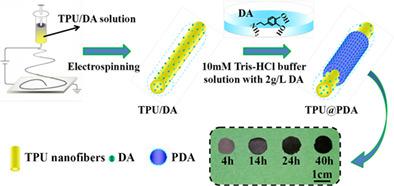当前位置:
X-MOL 学术
›
J. Appl. Polym. Sci.
›
论文详情
Our official English website, www.x-mol.net, welcomes your
feedback! (Note: you will need to create a separate account there.)
Modification of thermoplastic polyurethane nanofiber membranes by in situ polydopamine coating for tissue engineering
Journal of Applied Polymer Science ( IF 2.7 ) Pub Date : 2020-03-25 , DOI: 10.1002/app.49252 Jixin Lin 1, 2, 3 , Weiwen Wang 1, 2, 3 , Jiaqi Cheng 1, 2, 3 , Zhixiang Cui 1, 2, 3 , Junhui Si 1, 2, 3 , Qianting Wang 1, 2, 3 , Wenzhe Chen 1, 2, 3
Journal of Applied Polymer Science ( IF 2.7 ) Pub Date : 2020-03-25 , DOI: 10.1002/app.49252 Jixin Lin 1, 2, 3 , Weiwen Wang 1, 2, 3 , Jiaqi Cheng 1, 2, 3 , Zhixiang Cui 1, 2, 3 , Junhui Si 1, 2, 3 , Qianting Wang 1, 2, 3 , Wenzhe Chen 1, 2, 3
Affiliation

|
To improve the interaction between cells and scaffolds, the appropriate surface chemical property is very important for tissue engineering scaffolds. In this work, the dopamine (DA) was first introduced into thermoplastic polyurethane (TPU) matrix to obtain TPU/DA nanofibers by electrospinning. Subsequently, the TPU@polydopamine (PDA) composite nanofibers with core/shell structure were fabricated by in situ polymerization of PDA. In comparison with TPU nanofibers, the uniformization of PDA coating layer on the surface of TPU/DA composite nanofibers significantly increased due to the addition of DA, which used as the active sites to guide the PDA particles accumulated along with the fiber direction. The hydrophilicity and water uptake ability of TPU@PDA composite nanofibers were larger than those of TPU nanofibers. The TPU@PDA composite nanofibers possess excellent comprehensive mechanical properties of high strength, stiffness, elasticity, and recoverability because of the hydrogen bonding occurrence between PDA and DA, as well as between PDA and TPU matrix. The attachment and viability of mouse embryonic osteoblasts cells (MC3T3‐E1) cultured on TPU@PDA composite nanofibers were obviously enhanced compared with TPU nanofibers. Those results suggested that the modified TPU@PDA composite nanofibers have superior mechanical and biological properties, which promoting them potentially useful for tissue engineering scaffolds.
中文翻译:

原位聚多巴胺涂层对热塑性聚氨酯纳米纤维膜的组织工程改性
为了改善细胞和支架之间的相互作用,适当的表面化学性质对于组织工程支架非常重要。在这项工作中,首先将多巴胺(DA)引入热塑性聚氨酯(TPU)基体中,通过电纺丝获得TPU / DA纳米纤维。随后,通过PDA的原位聚合制备了具有核/壳结构的TPU @聚多巴胺(PDA)复合纳米纤维。与TPU纳米纤维相比,由于添加了DA,DA在TPU / DA复合纳米纤维表面上的PDA涂层的均匀性显着提高,DA被用作沿纤维方向引导聚积的PDA颗粒的活性位点。TPU @ PDA复合纳米纤维的亲水性和吸水能力大于TPU纳米纤维。由于PDA与DA之间以及PDA与TPU基体之间发生氢键键合,因此TPU @ PDA复合纳米纤维具有优异的综合机械性能,包括高强度,刚度,弹性和可恢复性。与TPU纳米纤维相比,在TPU @ PDA复合纳米纤维上培养的小鼠胚胎成骨细胞(MC3T3-E1)的附着力和生存力明显增强。这些结果表明,改性的TPU @ PDA复合纳米纤维具有优异的机械和生物学性能,从而促进了它们对组织工程支架的潜在应用。与TPU纳米纤维相比,在TPU @ PDA复合纳米纤维上培养的小鼠胚胎成骨细胞(MC3T3-E1)的附着力和活力明显增强。这些结果表明,改性的TPU @ PDA复合纳米纤维具有优异的机械和生物学性能,从而促进了它们对组织工程支架的潜在应用。与TPU纳米纤维相比,在TPU @ PDA复合纳米纤维上培养的小鼠胚胎成骨细胞(MC3T3-E1)的附着力和生存力明显增强。这些结果表明,改性的TPU @ PDA复合纳米纤维具有优异的机械和生物学性能,从而促进了它们对组织工程支架的潜在应用。
更新日期:2020-03-25
中文翻译:

原位聚多巴胺涂层对热塑性聚氨酯纳米纤维膜的组织工程改性
为了改善细胞和支架之间的相互作用,适当的表面化学性质对于组织工程支架非常重要。在这项工作中,首先将多巴胺(DA)引入热塑性聚氨酯(TPU)基体中,通过电纺丝获得TPU / DA纳米纤维。随后,通过PDA的原位聚合制备了具有核/壳结构的TPU @聚多巴胺(PDA)复合纳米纤维。与TPU纳米纤维相比,由于添加了DA,DA在TPU / DA复合纳米纤维表面上的PDA涂层的均匀性显着提高,DA被用作沿纤维方向引导聚积的PDA颗粒的活性位点。TPU @ PDA复合纳米纤维的亲水性和吸水能力大于TPU纳米纤维。由于PDA与DA之间以及PDA与TPU基体之间发生氢键键合,因此TPU @ PDA复合纳米纤维具有优异的综合机械性能,包括高强度,刚度,弹性和可恢复性。与TPU纳米纤维相比,在TPU @ PDA复合纳米纤维上培养的小鼠胚胎成骨细胞(MC3T3-E1)的附着力和生存力明显增强。这些结果表明,改性的TPU @ PDA复合纳米纤维具有优异的机械和生物学性能,从而促进了它们对组织工程支架的潜在应用。与TPU纳米纤维相比,在TPU @ PDA复合纳米纤维上培养的小鼠胚胎成骨细胞(MC3T3-E1)的附着力和活力明显增强。这些结果表明,改性的TPU @ PDA复合纳米纤维具有优异的机械和生物学性能,从而促进了它们对组织工程支架的潜在应用。与TPU纳米纤维相比,在TPU @ PDA复合纳米纤维上培养的小鼠胚胎成骨细胞(MC3T3-E1)的附着力和生存力明显增强。这些结果表明,改性的TPU @ PDA复合纳米纤维具有优异的机械和生物学性能,从而促进了它们对组织工程支架的潜在应用。











































 京公网安备 11010802027423号
京公网安备 11010802027423号